By Chris Becker
Here’s my roundup of what happened this week in major macro markets. Remember, the following views are my own, do not constitute advice and are for information purposes only. I may have positions in any or all of the below and their associated markets both long and short, on an intra-day, daily and weekly basis for my own account. Please seek advice from a licensed adviser before making any investment decisions.
Currencies and Gold – The Currency Wars Episode V?
The US Dollar Index (DXY) is made up of a basket of major currency pairs against the USD, but mainly the euro. For a while now it has been the major “risk on/risk off” indicator, with a lower USD usually meaning higher risk as US stock markets rise and push other risk assets higher, such as our own share market.
Staring with the weekly chart you can see that in comparison with QE2, where the DXY declined some 12%, QE3 is slowly becoming more “successful” as the USD slowly “wins” the currency wars. While the DXY is just below its 200 day moving average (the red line in all charts) it continues to find strong support at the 79 level, as shown by the directionless ADX indicator below:
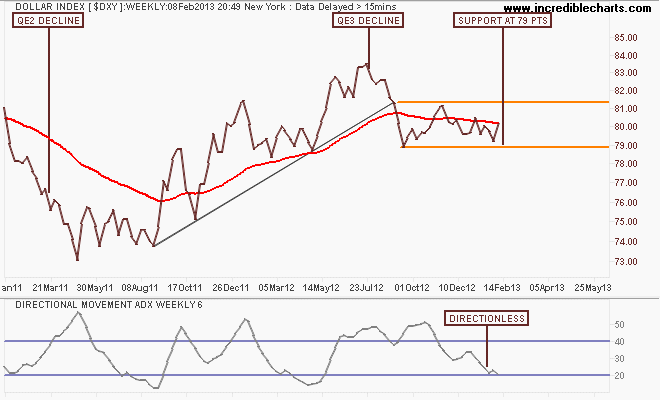
On the daily chart, this past week has seen the USD strengthen (or more appropriately the other currencies weakening), bouncing off support, but not making any new highs in the medium term:
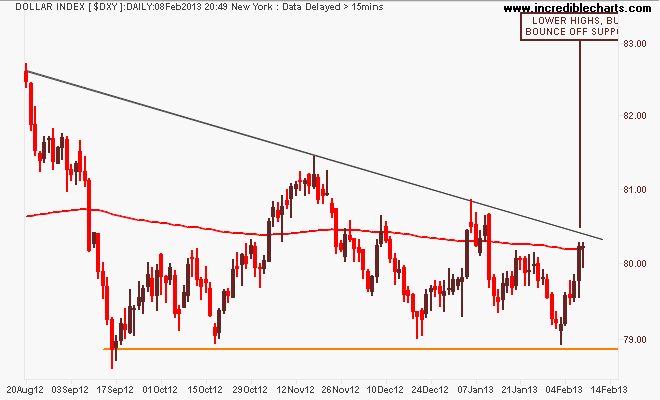
Because of its composition, the general opposite of the DXY is the euro (EUR/USD). In my last Technicals report at Macro Investor, I noted that after its break of the year plus down trend in August last year, the euro had broken out above resistance (former support) at the 1.31 level on the weekly chart. It has continued this trend, albeit after a hiccup during the US fiscal cliff saga, and with a reversal this week:
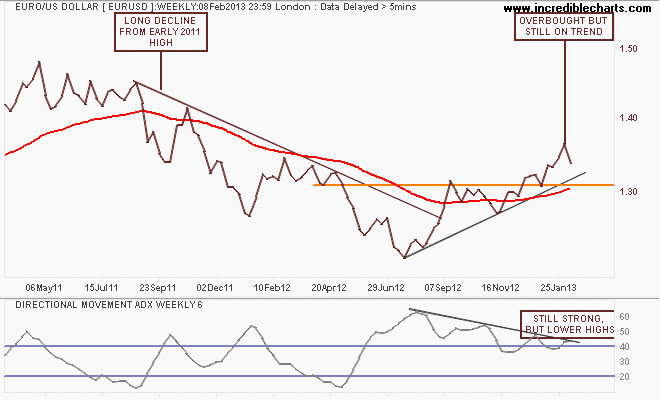
I pointed out on the daily chart last week with a pullback to 1.32 was likely. Note that the weekly ADX above while strong is making lower highs – are we out of puff here?
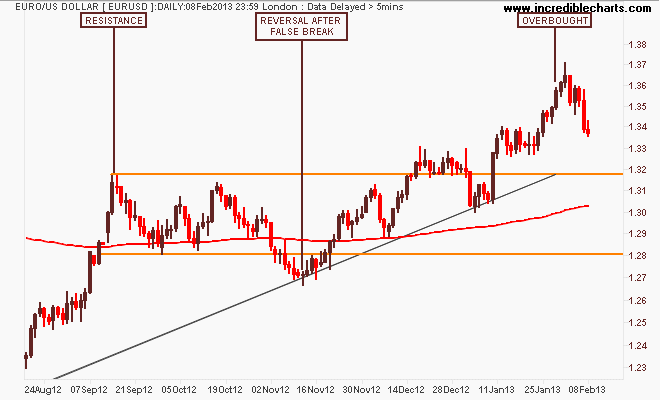
Time to look at the AUD again. The Aussie “battler” (AUDUSD) is refusing to walk to the tune of the loud and proud economists out there, hitting resistance and sliding back to intermediate support around the 1.02 handle, and right on its trend line from the August 2010 lows:
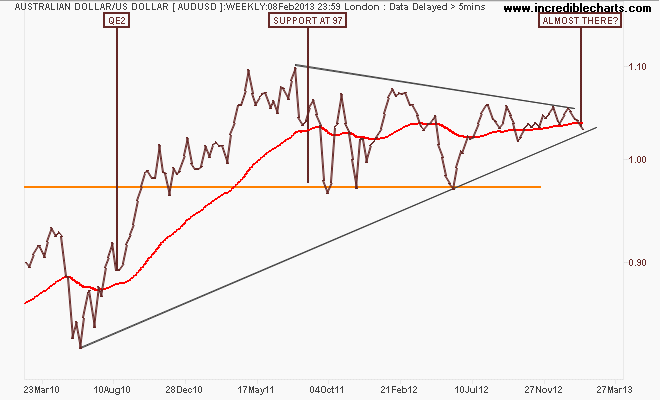
On the daily chart below you can see the sideways bullish condition is wavering, although weekly ADX continues to go nowhere. As I said last week, not a time to short just yet for the bears (or for the bulls to gloat about the “pain trade”):
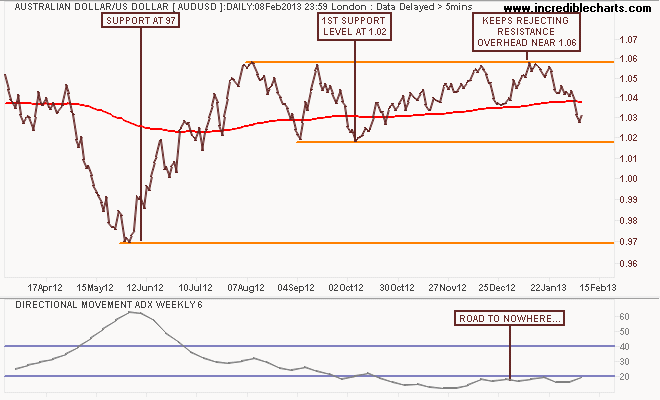
I’ll finish the currency section with the undollar currency, gold (USD). The main precious metal (I also trade silver, palladium and platinum) continues to confound the gold bugs and bears alike, although one does have to tip their hat to the bulls side, for now.
The medium term frustration can be seen on the weekly chart, with a sideways move for nearly 18 months with resistance at $1800 and support at $1560 per ounce providing the boundaries, but there is a slowly rising tend of higher lows:
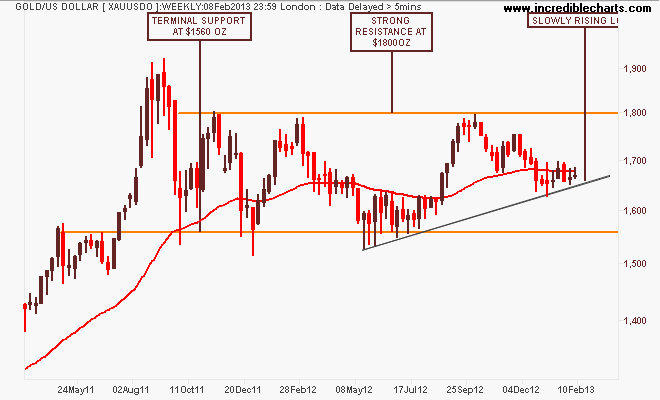
But the short term position remains bearish (or not long, as indicated by my MACD-H filter in the chart below) until a breakout above $1700:
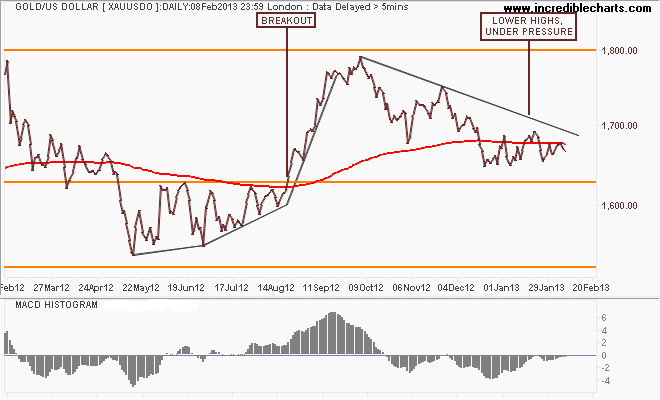
Commodities
For Australian investors particularly, there’s three major commodities to watch – crude oil, copper and iron ore. I’ll leave the last to Houses and Holes (it’s non tradeable for retail/private investors anyhow – although FMG/AGO are excellent proxies, both of which I trade regularly now), but crude oil is a great barometer displaying both demand and US dollar weakness.
There are two markers in crude, Brent and WTI. Here’s ICE Brent Crude, with the weekly chart of the spot price showing a breakout above resistance at $117 per barrel:
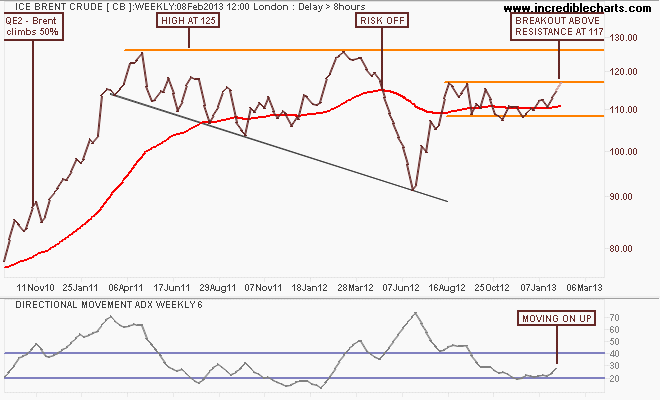
Looks like that rounding bottom pattern established at support at $106 per barrel, has worked so far. As I said last week. I’m long here on my weekly system, but I have my doubts about Brent because resistance above at $125 does not bode for high risk/reward trades. But this currency war could see a much larger move, particularly if those evil speculators (guilty) start bidding commodities up:
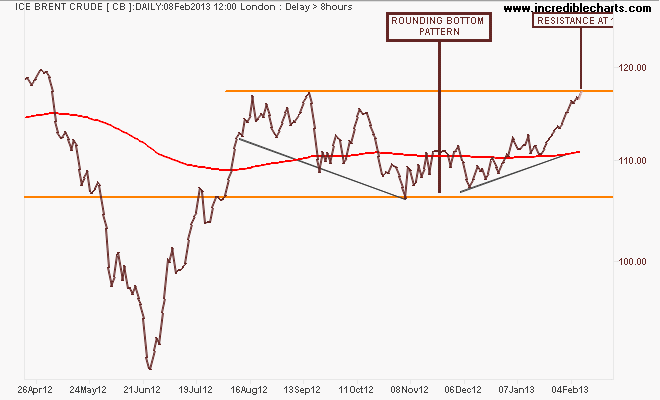
Copper is the other significant marker that is facing more resistance from overhead than Brent. Indeed WTI Crude has a more similar pattern to copper than its heavier brother. Dr Copper is behaving weak overall compared to the significant move during QE2, but a breakout above $8600 per tonne would surely give confirmation to a real bull market in risk:
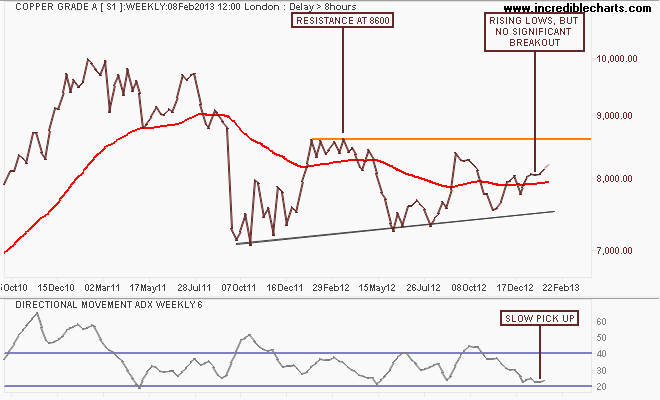
On a shorter time frame the metal remains volatile, albeit with a bullish bias, where the reversal of the August breakout last year has been completed as it looks like spot price has broken above the 8100 key level but hitting overhead resistance. This is definitely one market to watch:
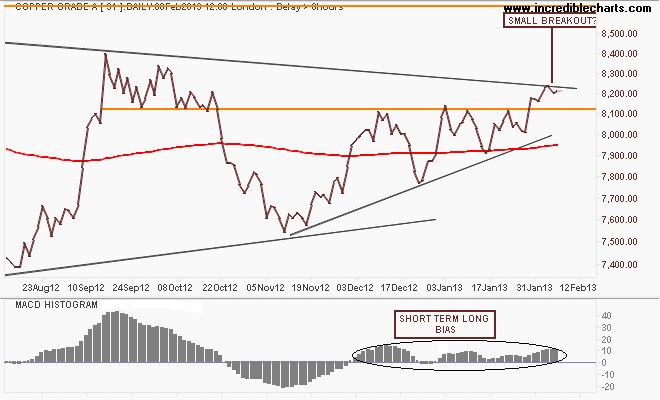
Stocks
Now to stocks, actually first the VIX, now almost at pre GFC levels. Cheap, cheap, cheap:
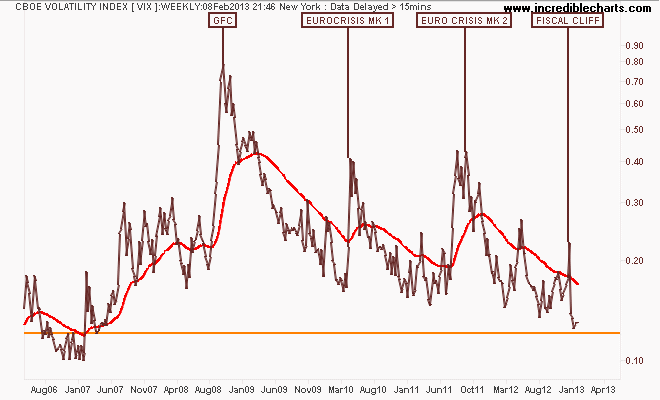
First off, isn’t the US S&P500 index doing swimmingly, with QE3 finally pushing it above pre-Lehman crisis levels. The historic pre-GFC high at 1550 points has always been my target, but I’ve been surprised – post fiscal cliff frivolity- with the speedy move so far in the new year. I’m concerned that this represents a similar mood to the blowoff rally in 2007, with an increased likelihood of a pullback or correction to the lower trend line down to 1400 points or so:
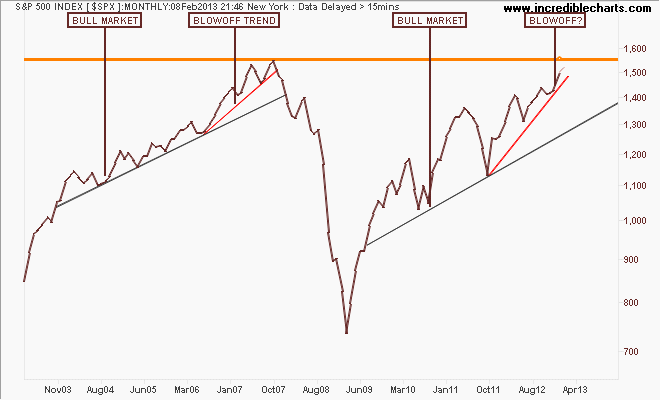
The weekly chart shows how the series of higher highs is smaller on each up cycle which has two meanings. This is a true “buy the dip” cyclical bull market, with each fall exciting the minority bears (to their chagrin) and thus enticing the bulls who have the Fed on their majority side. The problem is it’s taking more effort but the new highs are not of the same magnitude: can this continue? Note also that weekly ADX is now in blowoff territory:
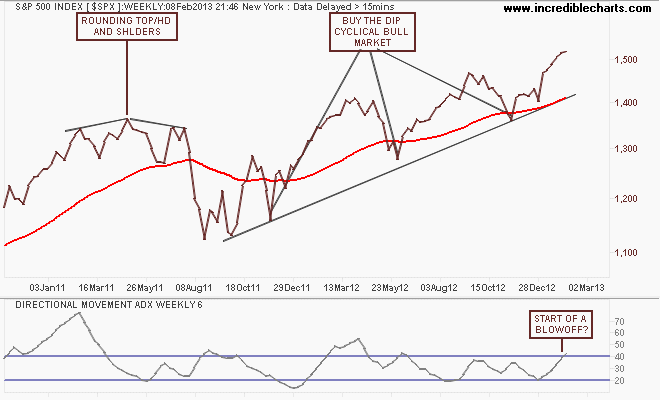
As I said last week, the main concern as an analyst is that this price movement – another Minsky stability/instability paradox – is precisely the type of last hurrah moves we see at the end of bull markets. But as a trader, it’s my job to be profitable and rely upon my positions, not opinions. When in Rome…here are my trading signals , note the long bias on the MACDH:
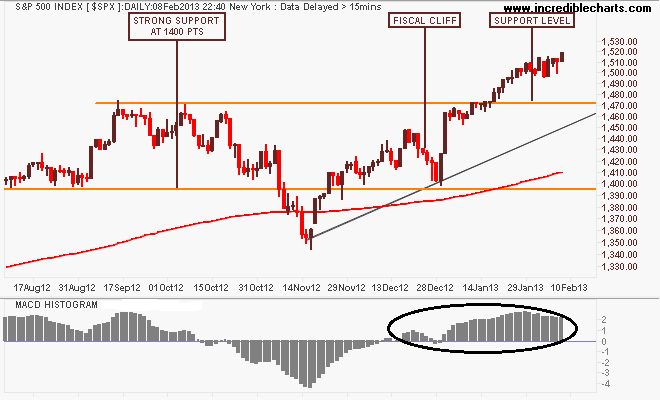
I have a stop at around 1480 points, triggered on a fall below 1500 points, with a short entry trigger somewhere below that with a possible target to strong support at 1400 points. Although the short term ADX has rolled over, there was a very positive night last night and the hourly charts point to very strong support.
The S&P/ASX200 index has been in a cyclical bull market within its secular bear market and is just 5 points below its April 2011 high at 4976 points. Note these key levels carefully at 3800-4000 (strong support), 4400 (intermediate resistance and the outer edge of the index’s real value), 4900-5000 (strong resistance) and 6850 (the former high of the 2003-2007 bubble):
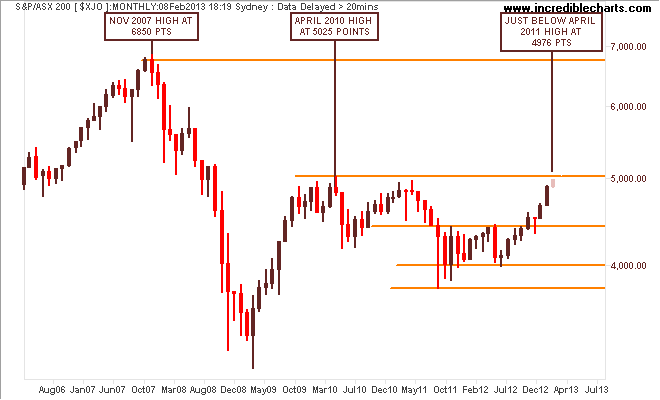
So is this it? Are we in a new “grand bull market”. Two things – first, share markets are not a reflection of economic strength, as measured by GDP or unemployment or a host of other measures. Secondly, no one will know the answer to that question until after the fact. My definition of a “new bull market” is one that is higher than the last bull markets nominal high – in this case, above 7000 points.
We’ve been in a cylcical bull market since the breakout above 4400 points and in the six years since the GFC, the secular bear market is going right according to historical guidelines. We’ve had the rebound rally, the correction (2011), and now we are in a trading range:
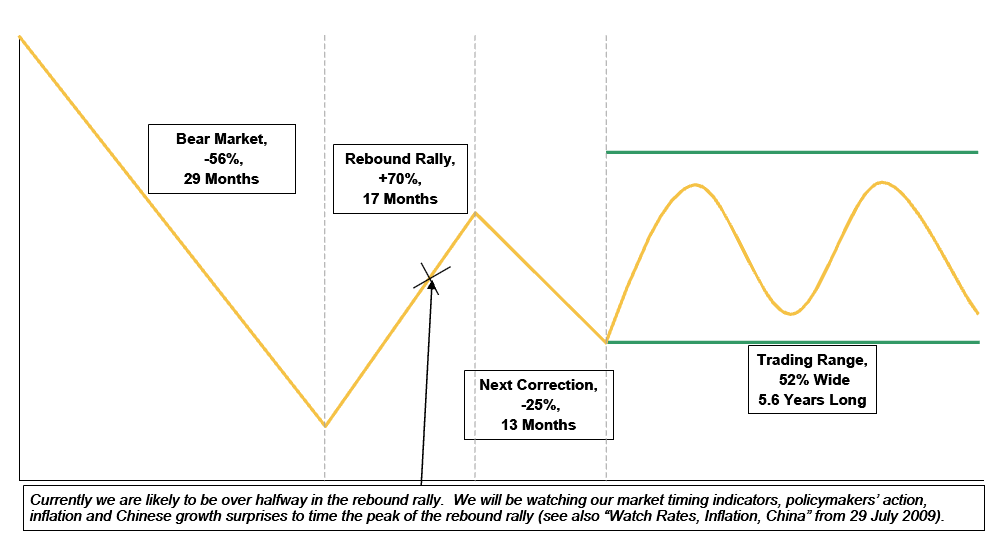
This is where the permabulls call for “new grand bull market” when we hit the top of the trading range, and the permabears call for lower lows when we hit the low of the trading range…..
I’ll leave the macro connotations and analysis to another day, I’m here to discuss price. Ill let the charts do the talking. Note how the weekly ADX is slightly…cough…overbought:
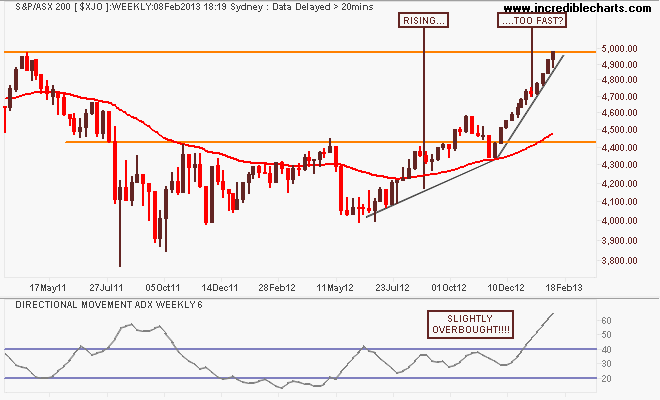
Last week I suggested that a sizeable correction back to 4600 points would provide greater strength for a rally to break through 5000 points and further into 2013. But as I said last year, it will take the materials sector to provide that push, as financials are extremely over-bought. The last time they were this extended was the end of the 2009 reflation rally or the bottom of the last correction:
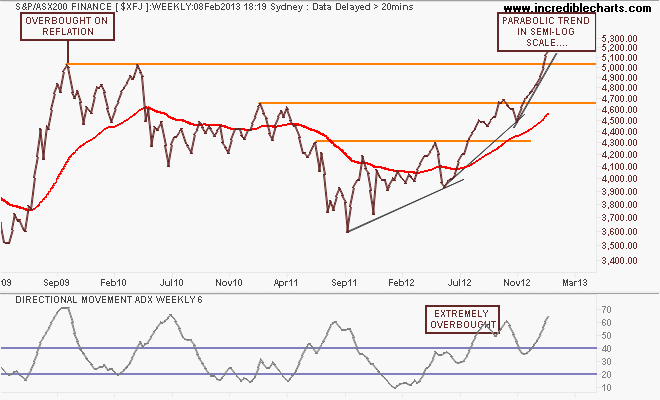
The Industrials sector (which are now out-performing financials in the last 4 months) could help here as the AUD falters against the majors, helping what’s left of our export industry, but is stuck in a classic trading range:
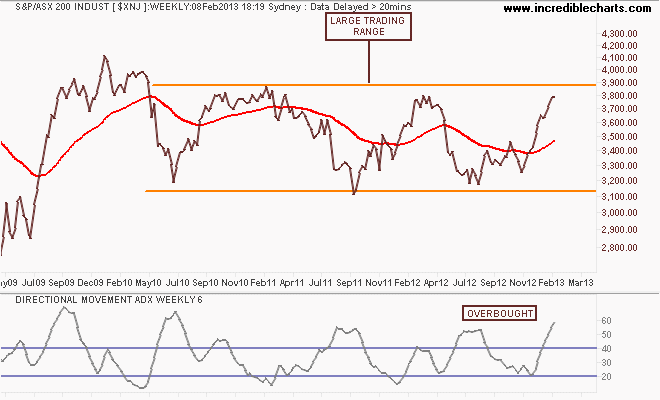
As you can see in the chart below, the Hang Seng China Enterprise Index (HSCEI) is leading the ASX200 Materials, now above its early 2012 highs, but has retraced slightly going into Chinese NY. The latter is approaching resistance, former support just below 11000 points and is also well overbought:
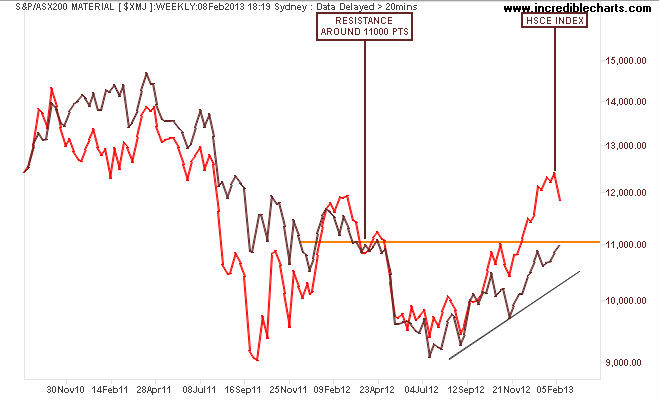
Now we’re into mid-year reporting season, we will see if the industrials are worth their price; if the financials can continue to breathe profits out of thin air and if materials can catch up to the Chinese and Japanese equity surges and/or if those surges can continue on monetary entanglement.
That’s all, see you next week and stay safe.
